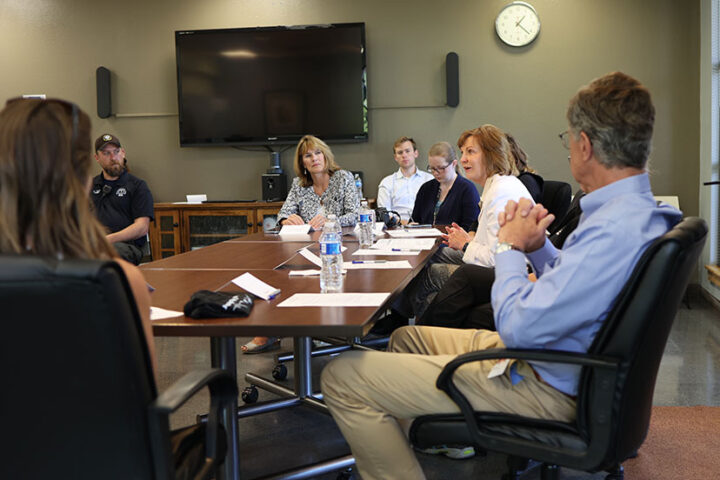PHOTO: U.S. Senator John Hickenlooper sitting with Upper San Juan Health Services District board president Kate Alfred, during a conference at Pagosa Springs Medical Center, June 28, 2023. Photos by Laura Vanoni for the Daily Post.
After we heard from Archuleta County Commmissioner Warren Brown urge our visiting dignitary — U.S. Senator John Hickenlooper — to consider ways to help fund an expanded Archuleta County airport, we next heard from PSMC CEO Dr. Rhonda Webb, explaining some of the challenges faced by a rural hospital in navigating “a broken health care system.”
Seated around the table with Commissioner Brown and CEO Webb were Pagosa Springs Medical Center staff and USJHSD board members.
Dr. Webb noted that PSMC is the largest employer in Pagosa Springs, and has added a wide variety of medical services over the past 15 years.
Nevertheless, the provision of health care remains a challenge. Not just in Pagosa, but everywhere in the U.S.
“We run a very tight margin. Always have. We had a negative margin last year…
“And you know, as funds get pulled from us, it becomes a problem to provide those services. And our ambulance service is one of those… I always tell people that we lose money on the ambulance service, and that’s what happens… but we get calls from UCHealth and all these big trauma centers, about what a great job our EMS did out in the field, and what we did, to get people out of here… it’s pretty exciting…”
“One of the things that Medicare has recently done, to try and help rural hospitals, is they’ve established a designation called ‘Rural Emergency Hospital’…”
Rural Emergency Hospitals (REHs) are a new provider type established by the Consolidated Appropriations Act, 2021 to address the growing concern over closures of rural hospitals.
PSMC is currently designated by Medicare as a ‘Critical Access Hospital’ (CAH) which entitles PSMC to receive enhanced Medicare payments — up to 99% of costs for a patient’s care and treatment. That’s much more generous than typical Medicare disbursements, and this very designation — CAH— was the reason why the USJHSD board believed, back in 2006, that Pagosa Springs could afford to create a hospital here, in the middle of nowhere. CAHs may have no more than in-patient 25 beds and must have an average duration of hospital stay under 96 hours. They must also be more than 35 miles from another hospital, with exceptions allowed for areas with poor roads or difficult terrain.
Dr. Webb:
“If we were a ‘Rural Emergency Hospital’, then Medicare would give us more money [for Medicare patients] — which our finance department would love to have — but in exchange for that, we would have to give up in-patient beds. And so it comes back to the fact that you’d be taking away services…”
Senator Hickenlooper:
“Why do you have to give up beds? I don’t understand.”
Dr. Webb:
“You can’t have in-patient beds and be a ‘Rural Emergency Hospital’. They were trying [to be helpful] but they just missed that one detail for us. Because… yes, more Medicare dollars would be available, but if your 80-year-old mother came in with, say, pneumonia, she would have to be transferred to… well, Durango is the nearest hospital. Or some other place. So we want to keep patients here. Patients want to stay here. It’s just easier for everybody, and we provide good quality care…”
Dr. Webb then brought up the Save Rural Hospitals Act currently being considered in the U.S. Congress.
“The Senate and the House versions are quite different, right?”
Senator Hickenlooper pretended surprise. “No!?”
The room responded with healthy laughter.
The Save Rural Hospitals Act, as introduced last April by Senators Mark Warner (D-Va.) and Marsha Blackburn (R-Tenn.) would establish a national minimum reimbursement rate, resulting in an infusion of new federal dollars to rural hospitals.
“This will ensure that rural hospitals receive more appropriate payment amounts for the care they provide to their patients and enable better accounting for the rising labor costs in rural communities,” the American Hospital Association wrote, in a letter of support.
Dr. Webb:
“We do have a lot of financial pressures here. We’ve had increasing expenses. Our labor costs are huge. The workforce is… gone from health care. We’ve lost… maybe 20%?”
There’s no doubt that practically every employer is Pagosa Springs is struggling with a reduced supply of qualified employees, but the qualifications for medical workers tend to be somewhat higher than for, say, retail or tourist industry jobs. But I believe Dr. Webb’s estimate — that “20%” of the workforce in health care has disappeared — comes from estimates published in the mainstream media during the COVID crisis, when medical workers were quitting en mass.
Back then, several news articles documented a significant drop in health care employment.
But things have changed since then, nationally, for the health care industry.
During the three decades prior to the COVID outbreak, employment growth in the health care industry far outstripped growth in the general U.S. economy.
According to a fascinating January 2023 article on the ‘Health System Tracker’ website — a collaborative effort funded in part by the Kaiser Family Foundation — America’s health industry employment doubled between 1990 and 2020, from about 800,000 workers to about 1.6 million.
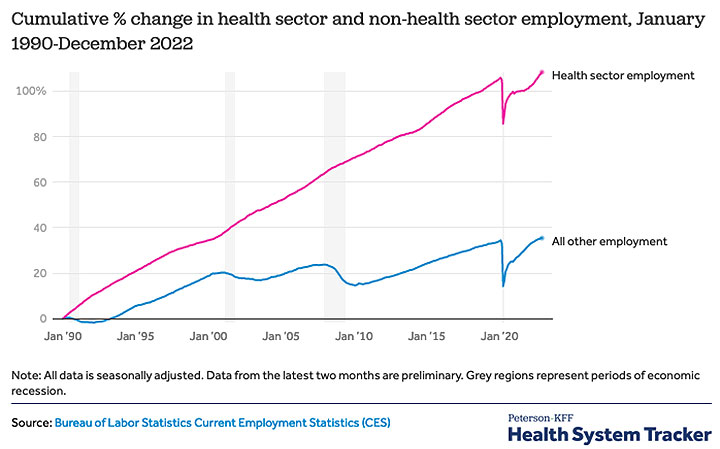
As we see, above, even during the 2000-2001 recession, and the Great Recession from 2008-2009, employment in the health care industry continued to increase, while other industries saw significant job losses that lingered for several years.
The COVID crisis saw a different result in 2020, with dramatic, and sudden, job losses in all industries, including the health sector. By December 2022, however, most industry sectors had recovered to 2019 levels. But not all.
Below is a graph for health sector employment, from 2020 through the end of 2022. As we can see, job growth — or lack thereof — has been very different in different sub-sectors.
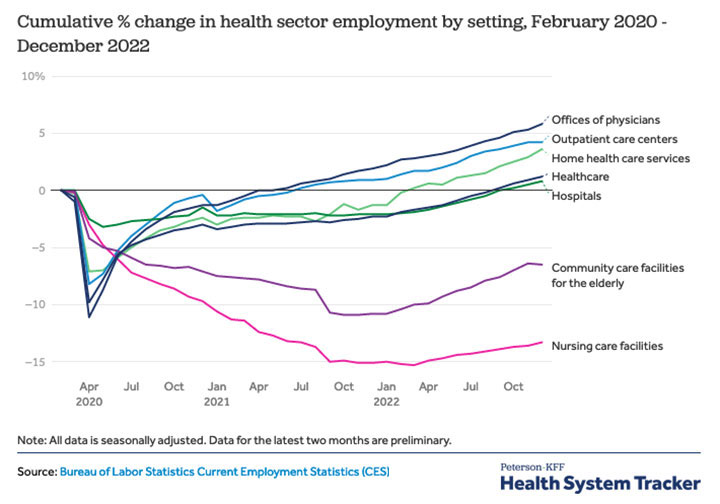
Employment in nursing care facilities fell off slowly… but then has remained comparatively low, down about 13% since the start of the COVID crisis.
Hospital employment, meanwhile, dropped relatively little during the crisis, and is now at about 1% above February 2020.
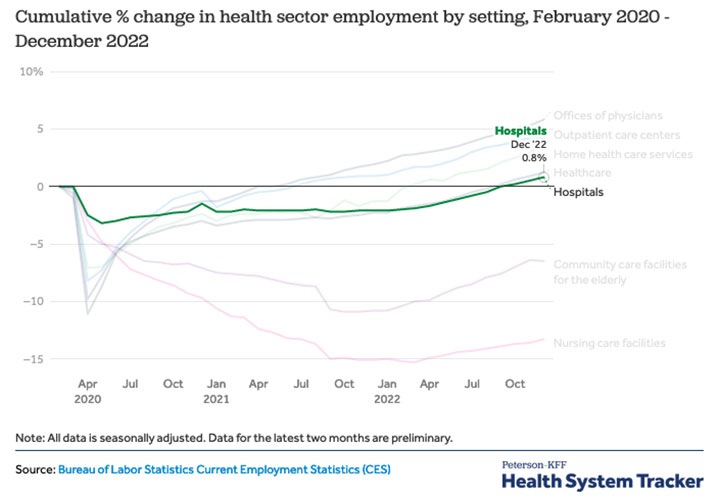
Employment in the health care industry as a whole is up about 1% from February 2020, but still below where it was previously projected to be, based on the growth patterns prior to 2020.
Here’s the curve for ‘Nursing care facilities’. As we can see, the current crisis seems to be in nursing care.
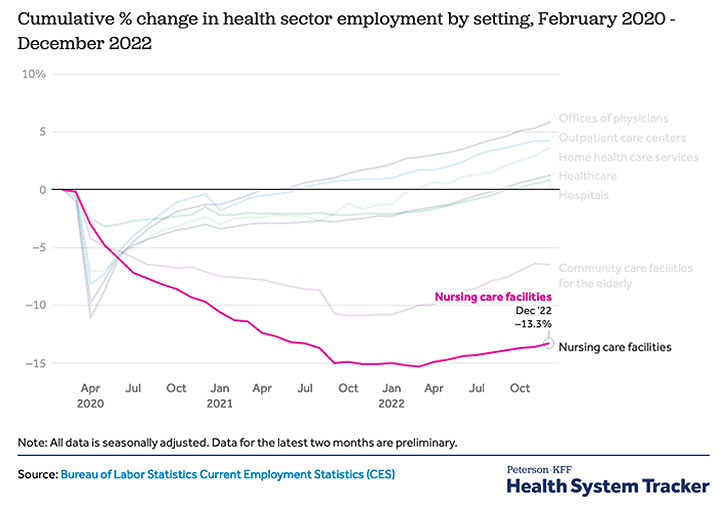
Unfortunately, these are national figures, and don’t necessarily apply to a community like Pagosa Springs, where a serious housing shortage — for working families and individuals — continues to hamper efforts to find qualified employees.
Especially, perhaps, at Pagosa Springs Medical Center…


